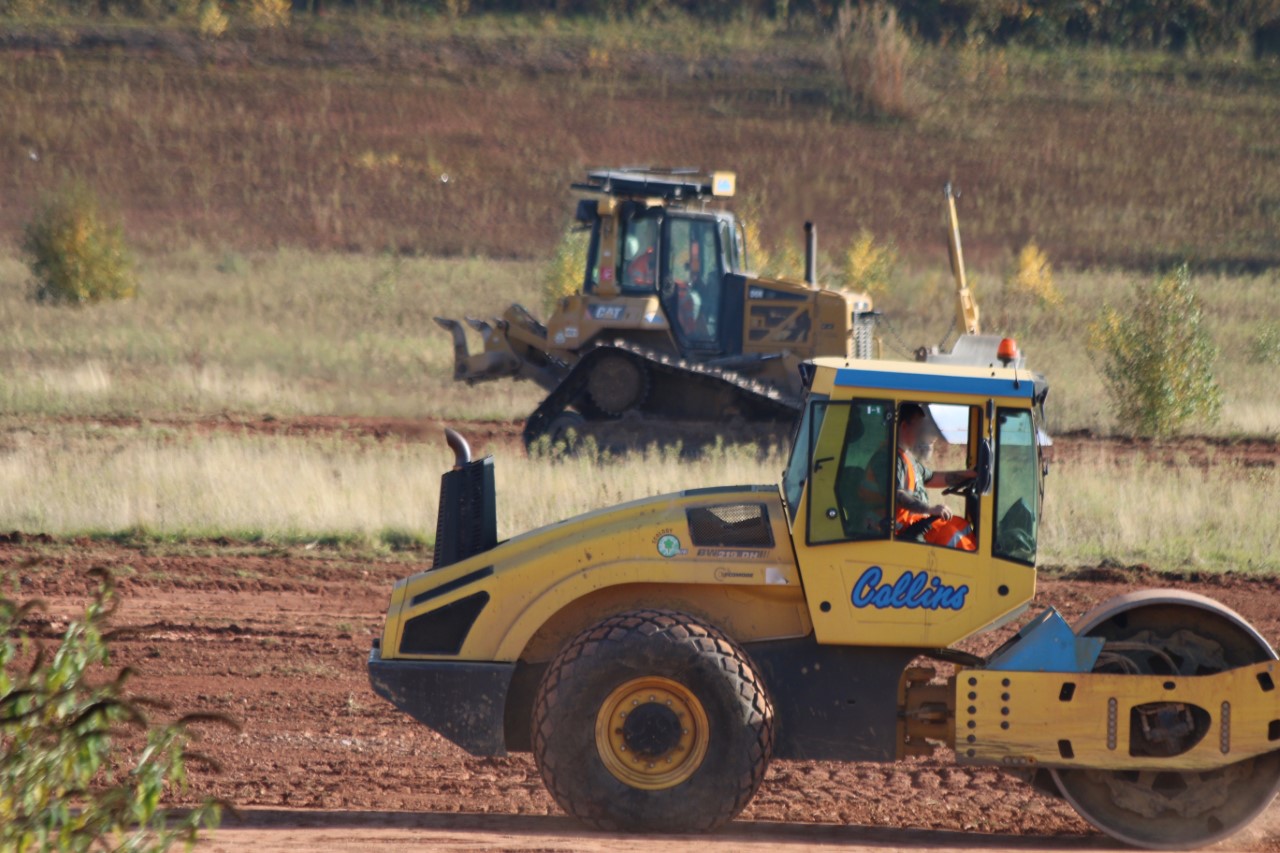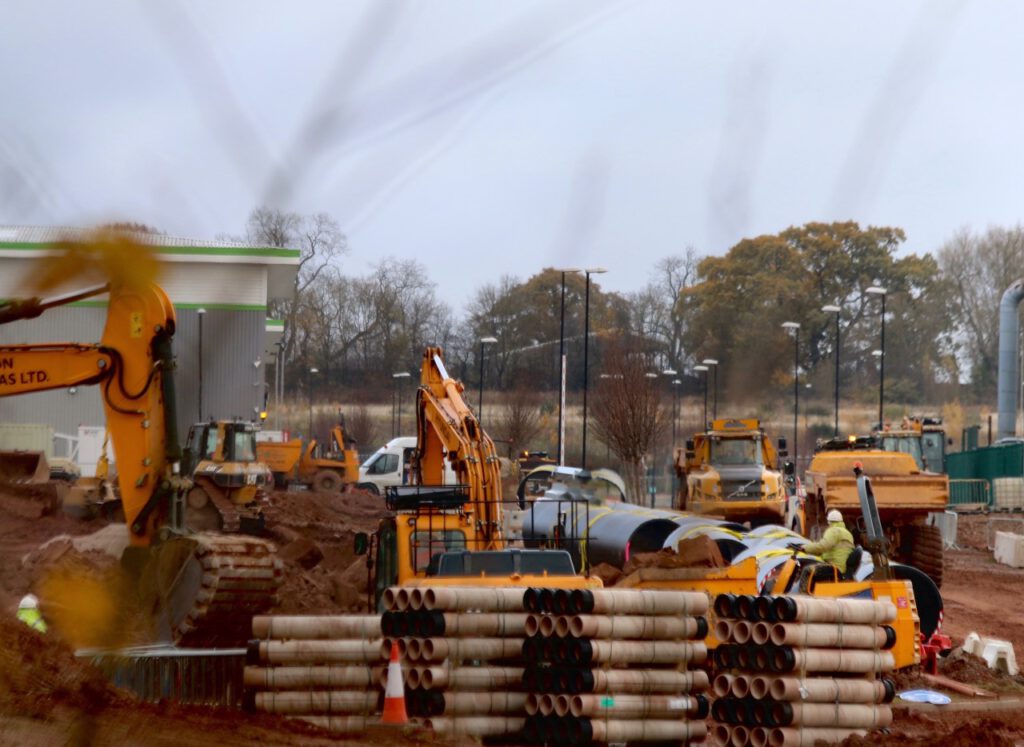By Rich Copland, a local activist
This article documents the personal experiences of a local environmental justice campaigner, in his own words:
Background
Lyons Park has been a large and very busy industrial site over the past seven decades. It is situated in the semi-rural Allesley Village on the west side of Coventry, and is on the immediate boundary of Coundon Wedge, which was formally designated as a local Wildlife Site.
During the Second World War it was a shadow factory, producing aircraft engines, making it a prime target for German bombers. Though large parts of Coventry were destroyed in the Blitz, Lyon Park escaped largely unscathed and Jaguar cars took over the site in the early 1950s, and it become Jaguar’s main car production site until 1998. Jaguar then shifted most of their operations elsewhere, retaining only a wood veneer factory and pilot build workshop on the site.
An Australian property group called Macquarie Goodman bought the brownfield site in 2007. Since then, a housing estate, several warehouses and a high-tech manufacturing unit have been built there.
One large area on Lyons Park remained vacant however, and an application was made several years ago to build a very large warehouse for Peugeot. However, this warehouse was not considered appropriate as it was far too large for its surroundings and would not have provided the type of skilled employment that the City Council wished to promote. The application was therefore rejected.
Notice of planning applications
 In September 2016, without the prior public consultation that had been promised, notice was given of new planning applications. The developers had unusually decided to split the planning application in two. The first application was only for extensive ‘ground levelling work’. They wanted to raise the levels by up to three meters.
In September 2016, without the prior public consultation that had been promised, notice was given of new planning applications. The developers had unusually decided to split the planning application in two. The first application was only for extensive ‘ground levelling work’. They wanted to raise the levels by up to three meters.
The second application was for the construction of an enormous distribution warehouse, with 500 Heavy Goods Vehicle movements every 24 hours. This was to be considerably larger than the Peugeot warehouse that was previously rejected, and as a local resident I was very concerned about the noise, congestion and other environmental issues this would cause. Adding to our worries, the identity of the customer was kept totally secret by the developers and by Coventry City Council.
What could I do?
I had no previous active involvement in planning or environmental issues and it was difficult to know how to respond effectively.
I had no previous active involvement in planning or environmental issues and it was difficult to know how to respond effectively. I started by sharing views with neighbors and friends, posting concerns on local social media sites, and making contact with members of the local Allesley and Coundon Wedge Conservation Society.
Because of the way the planning application was split, it was not possible to refer to any of the major concerns about the warehouse development in a written objection to the first application. Or even when speaking at the planning hearing regarding the first application.
The only issue that could be referred to at that stage was the ground levelling. I think this was a deliberate tactic by the developers to avoid effective challenges.
I looked at the Planning Department website, hoping to get some inspiration from other people’s objections. However, I discovered that the Planning Department had very recently decided to remove the full text of objections. They merely gave the numbers and categories of objections.
I then decided to submit a written objection about the negative impact the ground levelling would have on the local ecology and protected wildlife.
Concerns about planning documents
When I looked at the on-line documents submitted in support of the application I initially struggled to make sense of them. There were so many documents that it was difficult to know where to start. Some were written in obscure technical language, and others were very lengthy, so it was difficult to tease out the key issues. Some documents were just inaccurate or significantly out of date.
There were so many documents that it was difficult to know where to start. Some were written in obscure technical language, and others were very lengthy, so it was difficult to tease out the key issues.
 When I read through their Ecology report I was surprised that it had not identified the very significant ecology and wildlife that surrounded the site. There was no reference, for example, to the rare species and fragile ecology that led to Local Wildlife Site status. Nor did the report refer to the Badger setts within the woodland boundary, or local birds on the Red and Amber lists of Conservation Concern. It was generally dismissive of the ecological damage that ground levelling could create. It emerged that a comprehensive field survey, as normally required, had not been conducted and the document was a paper exercise that had failed to capture important readily-available data. I felt the report was essentially worthless.
When I read through their Ecology report I was surprised that it had not identified the very significant ecology and wildlife that surrounded the site. There was no reference, for example, to the rare species and fragile ecology that led to Local Wildlife Site status. Nor did the report refer to the Badger setts within the woodland boundary, or local birds on the Red and Amber lists of Conservation Concern. It was generally dismissive of the ecological damage that ground levelling could create. It emerged that a comprehensive field survey, as normally required, had not been conducted and the document was a paper exercise that had failed to capture important readily-available data. I felt the report was essentially worthless.
The first planning meeting
When I and others spoke at the first planning committee meeting we were each told by the chairperson that we would be timed for three minutes, which gave very little opportunity to properly share our concerns. Some speakers were stopped mid-sentence as their 3 minutes expired. What’s more, most of the committee members did not appear to be listening to the objections.  They appeared bored with my presentation about the important ecological status of the surrounding countryside and the harm that could be caused to badgers, bats and other protected species by noisy machinery and nighttime light pollution.
They appeared bored with my presentation about the important ecological status of the surrounding countryside and the harm that could be caused to badgers, bats and other protected species by noisy machinery and nighttime light pollution.
What’s more, most of the committee members did not appear to be listening to the objections.
Unsurprisingly, the initial application for the earthworks was approved by the planning committee.
There was significant concern about the process of the meeting. When a request was submitted for a transcript of the meeting, we were told this was not possible because the recording equipment had ‘failed’.
Further concerns about planning documents
In preparation for the second planning application for the massive warehouse construction, I started reading through more on-line planning documents.
I was amazed at some of the content. The applicant’s Traffic Survey Data was many years out of date, therefore failed to record any of the three fatal incidents on local roads. Their traffic assessment also failed to recognize the severe traffic congestion that already exists on local roads, and that these roads would not cope with the demands of an extra 500 lorry movements every day.
The Flood Risk Assessment undertaken on behalf of the developers acknowledged that water discharge rates from the site will not comply with the Local Flood Plan’s run-off rates. They argued that it would be too expensive to comply with new flood prevention policy.
I wrote to the City Council’s Flood Risk Manager about increased flooding risk. He referred me to the Planning Department and vice versa. Neither provided any answers to my questions.
The Land Condition Review referred to reports spanning several years of potential risks from pollutant sources on site. It made repeated comments about Chromium pollution and in particular to the most toxic form – Chromium 6.
I therefore looked at Health and Safety guidance on Chromium 6 which advised that, amongst other risks, it is carcinogenic and can cause reproductive damage.
More pollution concerns
When I spoke with a neighbor about chemicals pollution on the site, he gave me a diagram from an earlier investigation which showed potential risks to workers and buildings on the site, together with wider risks to local water courses. I shared a copy of this with the Environment Agency, Severn Trent Water, members of the Planning Committee and the Wetlands Officer from Warwickshire Wildlife Trust, and local BBC radio.

Between the two planning meetings we had heavy rainfall which resulted in a large flood of mud pouring out of the site from where they had started levelling. This ran over local meadows and contributed to local flooding of fields when it entered the River Sherbourne.
After I posted photos of this on social media, local BBC radio requested an interview about the increased risk of flooding caused by the development. BBC staff were insistent however that no mention could be made of possible chromium contamination, as this may have alarmed their audience.
A member of the local conservation society shared concerns with the Environment Agency and Severn Trent Water about the mud effluent and potential pollution. This resulted in the developers being told to stop the mud from entering the River Sherbourne. Nevertheless, the effluent continued for two more days. I wrote to the Environment Agency and Severn Trent Water asking whether there was a risk of uncontrolled ground water run-off from the site causing pollution to local watercourses but they explained how one would need technical support to monitor such pollution.
Public consultation
A Public Meeting was arranged by the local conservation society and was attended by hundreds of concerned people. The key purpose was to hear from the Chief Planning Officer and representatives for the developers. However, they rejected the invitation. The developers said that they would offer a “drop in” evening instead, so that concerns could be addressed. However, this was cancelled by the developers at very short notice.
At the second planning meeting the microphones were not working properly, so there were serious problems in hearing what people were saying. Rather than welcoming interest in the democratic process, the Chairperson commented that it was “intimidating” to have so many members of the public present.
One member of the committee did focus on the issue of toxic contamination and warned of the possibility of having to demolish the warehouse if dangerous toxins were subsequently discovered. He asked the planning officers whether specific testing for contamination on the site had been undertaken. A planning officer only gave vague responses.
One councilor, who spoke in favor of the development, made unconvincing promises about the creation of high numbers of secure, well paid jobs, with trades union involvement, and guarantees of apprenticeships for every employee who wanted one.
But who were this mysterious company that the developers and by Coventry City Council had for so long kept secret from us? It was later revealed to be retail giant Amazon.
To our dismay, the application was approved by the planning committee.
Conclusion
What was most frustrating was the feeling of powerlessness in objecting to the development proposals.
On reflection, I found the Planning Committee process very unsatisfactory. What was most frustrating was the feeling of powerlessness in objecting to the development proposals. For example we had no access to legal, professional, or scientific support in scrutinizing the plans or in presenting our case. Indeed, the Committee appeared to have already made up their minds to approve the application. Voting took place along party political lines, and I remember the leader of the dominant party sitting sternly watching the vote.
 While the outcome has been disappointing, I’ve learnt a lot about planning processes and am now more confident about presenting written and verbal objections in the future. What makes me optimistic is that I’ve seen first-hand how individual concerns lead to community action. Next time we will be better prepared for a new campaign!
While the outcome has been disappointing, I’ve learnt a lot about planning processes and am now more confident about presenting written and verbal objections in the future. What makes me optimistic is that I’ve seen first-hand how individual concerns lead to community action. Next time we will be better prepared for a new campaign!
